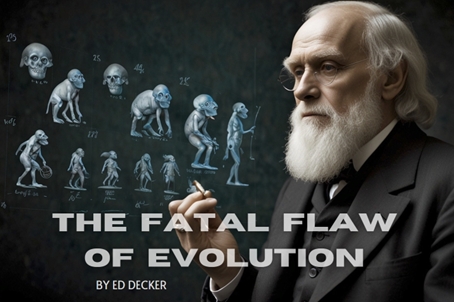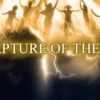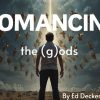“The Science of the Some-hows”

As you read through this report and my personal observations, I want you to know that this work is of my own hand with many references and its intent is to show you that the Theory of Evolution is, in fact and in evidence, far beyond the realm of Science Fiction. We were lied to when our schools taught it as a truth. Note, the illustrations below were AI-generated by typing in the name of the fossils.
I am going to go through the life cycles of a number of species here, in order to make the point that every living thing on this earth is part of a specific system of life cycles that are so consistent in their natures that it is beyond comprehension to even think that they somehow and without pattern grew from a huge explosion somewhere in outer space into the complex world we inhabit.
In fact, everything I have seen in almost 90 years, left to its own, sitting in some field out there never worked itself into something greater than itself. In fact it decomposed, collapsing into itself, rotting and rusting away .
I was thinking recently about what keeps everything together in our corner of the universe. I guess that’s a function of my very advanced age. I settled on the miracle of gravity, and its relationship to all living things on earth as my first entry into this article.
I thought about an earth that formed, supposedly through some big cosmic explosion somewhere out in the vast multitude of universes that somehow created this earth, that somehow ended up in an orbit around a massive sun, along with a bunch of similar orbs all screaming through space, spinning madly in perfect, proportional rates, all the while keeping perfect synergistic order over eons of time. I have some difficulty believing that could have happened when every explosion I have witnessed here on earth has brought destruction, not create complex systems of life.
The Evolutionary Theory of hundreds of thousands of eons of trial and error could never produce a single birth any more than eons of swirling gases could end up as breathable air capable of sustaining life on earth. Both the air breather and the air would have to mutate simultaneously to give and receive life sustaining air. No far-flung orbs cast into the heavens by that big bang could ‘somehow’ ever end up in specific orbit together around a sun, with living and breathing creatures roaming across its crust.
Then there is the breathable air that is a perfect mixture of gases, exactly what plants, and animals, including humans need to survive more than a few minutes without it. Somehow this one planet has this specific air and somehow it has a moon that orbits about it and somehow stays right where it is, regulating a perfect balance of gravity as it rotates around this earth. A lot of ‘some-hows’ to be any fact of true science.
I worked my way in and around the subject and I concluded that gravity is not a ‘somehow’ kind of thing. It is a precise and exact amount, and specifically calibrated to function in unity with the entire cosmos and keeping things from flying off the earth randomly into space. It is what keeps my feet on the ground.
If gravity was something a tiny bit weaker, it would destroy all life, if stronger, it would crush us all. Scientists say that the average gravitational pull of the Earth is 9.8 meters per second (m/s2). It is perfect and stays perfect.
By the way, the moon has a surface gravity of around 1.62 meters per second squared, according to NASA.
Now, when I get on the bathroom scale and I read the numbers, I am prone to say, “Hmm, the gravity must be a bit strong this morning.”
The scientifically touted Big Bang ‘Theory’ doesn’t make any more sense than the “Theory” of Evolution. I am sure I have over-simplified things that are radically complicated. But it doesn’t end there. Let me take you down a simple road that demonstrates the absolute delusion of evolution.
Lying awake at 3AM

A while ago, as I lay awake at 3 AM, my thoughts wandered around into the issue of the creation of mankind. Not your normal wandering mind. The next morning, I stepped away from my own Biblical position on creation and looked at the secular viewpoint. Charles Darwin called it the Theory of Evolution by Natural Selection.
I began to ponder the issue. I use the word, ponder because to ponder is to to think or consider especially quietly, soberly, and deeply. That’s what I was doing for the next few days.
I remember back when we students were told that all humans evolved over eons of time into who we are today. I am going to go through some of things we were taught in our scientific pursuit of who we are and how we arrived here. Remember that this is called a theory.
Webster defines the term as a plausible or scientifically acceptable general principle or body of principles offered to explain [Ed: unprovable] phenomena; an ideal or hypothetical set of facts, principles, or circumstances with synonyms Conjecture and Speculation.
‘Scientists’ say that “Evolution is the outcome of the interaction amongst the following five processes:
- Mutation
- Genetic Recombination
- Chromosomal Abnormalities
- Reproductive isolation
- Natural Selection
They break down the evolution of man and the Stages in Human Evolution down as follows.
NOTE: We used AI software to create these images simply using the name, they are for illustration purposes only and not intended to be a professional representation.
1. Dryopithecus

These are deemed to be the ancestors of both man and apes. They lived in China, Africa, Europe and India. The genus Dryopithecus refers to the oak wood apes. When Dryopithecus was alive, the tropical lowlands which it inhabited were densely forested, so the members could have predominantly been herbivores.
2. Ramapithecus
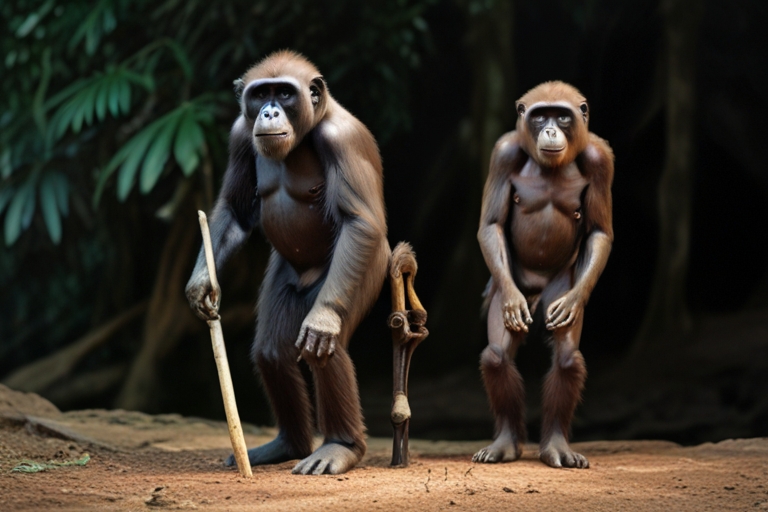
Their first remains were discovered from the Shivalik range in Punjab and later in Africa and Saudi Arabia. They lived in open grasslands. Two pieces of evidence confirm their Hominid status:
- Thickened tooth enamel, robust jaws and shorter canines.
- Usage of hands for food and defence and extrapolations of upright posture.
3. Australopithecus
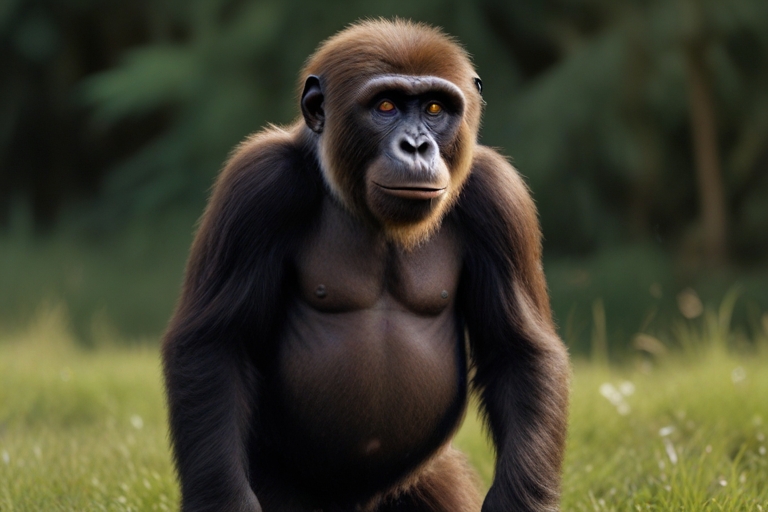
The fossil of this genus was first discovered in 1924 in South Africa. They lived on the ground, used stones as weapons and walked erect. They were 4 feet tall and weighed 60-80 pounds.
4. Homo Erectus
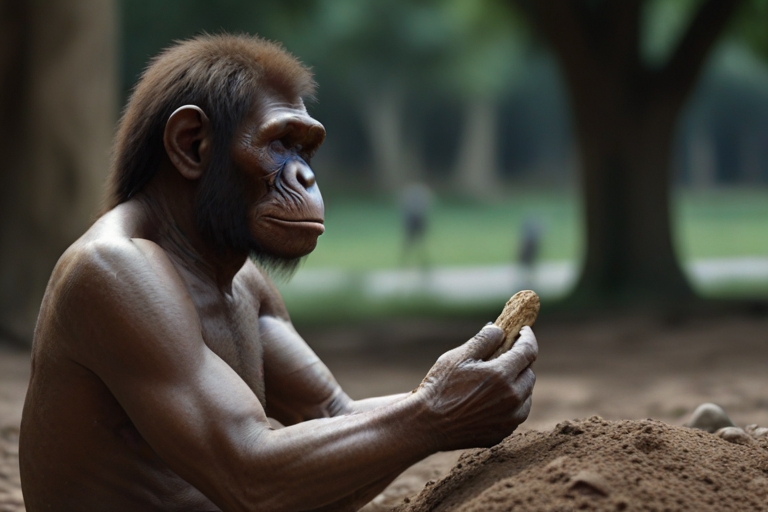
The first fossil of Homo Erectus was found in Java in 1891. These were named as Pithecanthropus Erectus. These were considered as the missing link between the man and apes. Another discovery made in China was the Peking man. This specimen had large cranial capacities and is believed to have lived in communities. Homo erectus used tools comprising quartz. Tools made of bones and wood were also discovered. There is evidence of collective huntings. There is also evidence of the use of fire. The Homo Erectus is believed to dwell in caves.
5. Homo Sapiens Neanderthalensis
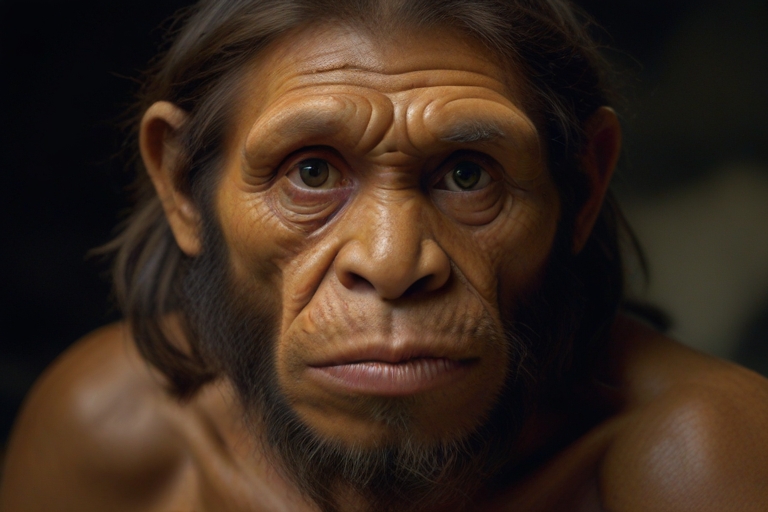
The Homo Erectus evolved into Homo Sapiens. During evolution two sub-species of Homo Sapiens were identified- Homo sapien Neanderthal and Homo sapiens sapiens. The cranial capacity of Neanderthal grew from 1200 to 1600 cc. Some small hand axes had also been discovered. This species of hominids could hunt big names such as mammoths.
6. Homo Sapiens Cro-Magnon
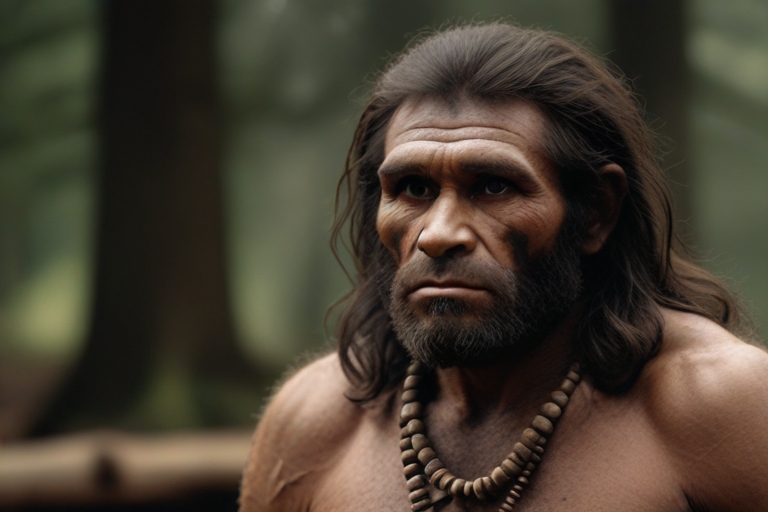
The remains of Homo Sapiens were first discovered in Europe and were named Cro-Magnon. In these, the jaws are quite reduced, the modern man’s chin appeared, and the skull was rounded. Their cranial capacity was about 1350 cc. They gathered food through hunting. Art first appeared during this time.
This is how “scientific“evolution took place.
https://byjus.com/biology/evolution-by-stages/
Remember later on that these hypotheses suggest that we are all descendants from the genus ‘Dryopithecus Oak Wood Apes’ who in their own evolutionary cycle, grew over eons of time from some microcosmic gooey thing in the sea.
Further study quickly brought me to Darwinism and the Origin of Species
The modern concept of evolution was proposed by Charles Darwin and was made renowned worldwide through his book, “On the Origin of Species” in 1859. The highlight of his work was that organisms, over a period of time, change as a result of behavioural or physical traits which are passed down from generation to generation. These changes enable an organism to better adapt to its environment and eventually pass on the traits to future generations. Those organisms that cannot adapt to change die out – hence the term “Survival of the fittest.” https://byjus.com/biology/evolution/
This is a preposterous bit of so-called science. We must assume that in order to procreate to the next generations somehow [a word that covers-all-the-holes-in-the-theory again], these organisms must have metamorphosed eventually into male and female super-globs who then morphed into post-globs who then found their opposite-sexed globs and copulated, bringing baby globs-pluses into being. These globs-plus offspring then repeated the process until all the flora and fauna of the earth were created. Mind boggling.
On its website, it stated this simple comment in an article regarding Darwin:
“Darwin referred to this process, in which groups of organisms change in their heritable traits over generations, as “descent with modification.”
Today, we call it evolution.
Darwin proposed that species can change over time, that new species come from pre-existing species, and that all species share a common ancestor.” https://www.khanacademy.org/
In the New Scientist Journal, Contributor Michael Marshall published an in-depth look at evolution on July 14, 2009, and updated it on April 27., 2023,, It is titled, Timeline: The evolution of life. In it, he goes through some of the many evolutionary theories, looking at the pluses and the minuses. I suggest you look at the report. https://www.newscientist.com/article/dn17453-timeline-the-evolution-of-life/
In his introduction to his review, he states that:
The story of evolution spans over 3 billion years and shows how microscopic single-celled organisms transformed Earth and gave rise to complex organisms like animals. [Ed: Don’t leave out the fish of the seas and the birds of the air. Oh, and don’t forget the trees]
That was a short look at the way we humans are defined by the scientific, secular world. There are as many theories, it would seem, as there are authors on the subject. All use the word, “scientific,” that supposedly makes their claims legitimate and irrefutable. Remember that not a single scientist was there to see any single one of the trillions of mutations needed to produce what they claim is evidence.
However, they all seem to hang on to the hypothesis that all life on earth comes from those “single-celled organisms [that] transformed Earth and gave rise to complex organisms like animals and we humans.”
However, as I read in Wikipedia, for a hypothesis to be a scientific hypothesis, the scientific method requires that one can test it. Yet in all the years since we acquired fingernails and opposing thumbs, there has never been a single “missing Link” that has been presented to prove the most minute part of even the very latest hypothesis.
Now this is the Biblical viewpoint of how we all arrived here
Genesis Chapter 1.
On The Sixth Day
6 Then God said, “Let Us make man in Our image, according to Our likeness; let them have dominion over the fish of the sea, over the birds of the air, and over the cattle, over [g]all the earth and over every creeping thing that creeps on the earth.” 27 So God created man in His own image; in the image of God He created him; male and female He created them. 28 Then God blessed them, and God said to them, “Be fruitful and multiply; fill the earth and subdue it; have dominion over the fish of the sea, over the birds of the air, and over every living thing that [h]moves on the earth.”
29 And God said, “See, I have given you every herb that yields seed which is on the face of all the earth, and every tree whose fruit yields seed; to you it shall be for food. 30 Also, to every beast of the earth, to every bird of the air, and to everything that creeps on the earth, in which there is [i]life, I have given every green herb for food”; and it was so. 31 Then God saw everything that He had made, and indeed it was very good. So the evening and the morning were the sixth day. [Genesis 1: 1-31]
Are you still with me?
Two diametrically opposing positions and they most definitely will never be reconciled, if you look at the scripture literally, as I do.
Let me wander back into the beginning of this billions of years process. Let’s start with Darwin. “The highlight of his work was that organisms, over a period of time, change as a result of behavioural or physical traits which are passed down from generation to generation. These changes enable an organism to better adapt to its environment and eventually pass on the traits to future generations.”
The first question one must ask is why would any “microscopic single-celled organism” be the least concerned about evolving into humans or any other highly complex beings? Were some thinking about becoming birds and others wanting to be fish? Did some feel like they needed to evolve into crocodiles or duck-billed platypuses? Must we accept the evolutionist’s theory that it all happened by chance, without purpose?
How were they motivated to morph into the many thousands of specie that they apparently evolved into. If I were a single celled microscopic glob, happily living my very simple and very short life span in a warm mud hole somewhere that is now Burma, I wouldn’t know a future elephant if it sat on me.
But here is where the evolutionary fantasy crumbles by its own weight. Microbe to complex humanoid may sound good in the realm of these self-mutilating hypotheses, but it just doesn’t work in reality.

Try to imagine any two completely separate single cell ‘creatures’ surviving the big bang, hurling through space, and evolving through near-eternity eons to create those fishes of the seas. Google says:
The total number of living fish species, about 32,000, is greater than the total of all other vertebrate species (amphibians, reptiles, birds, and mammals) combined.
That is about 32,000 females and another 32,000 males or a total of about 64,000 separate creatures. In order to become living beings, each of the sub-species needs to be fully able to produce off-spring as the very first creatures of that sub-species. Otherwise, there can be no sub-species.
Their method of procreation has to be identical to that of all the other 32,000 who are each in a very separate evolutionary route to fish-hood and are circling the oceans and seas across the globe as they seek out its single mate in order to mutate in perfect harmony with every other pre-fish of their subset.
Somewhere along the route, every male and female of their sub-species must mature separately and yet must simultaneously arrive at the reproduction cycle at the same time and place, somewhere across the vast waters. Remember that 71% of the earth surface is water, yet only 3% of the earths 333 million cubic miles of water is fresh water.
That unique timing must be exactly the same for every single one of the 32,000 subsets. It’s far greater in concept than in finding Nemo. It involves 32,000 sperm carriers and 32,000 egg carriers arriving at the same 3 or 4 square feet of water some random place on earth, all with fully working reproduction systems. All of whom must somehow know exactly how to procreate with the goal of having offspring they know nothing about.
Bear in mind that the reproductive organs of even fish are extremely complicated, and each single complex part must be in perfect order to reproduce. It is the same regarding the functions and survival of every species.
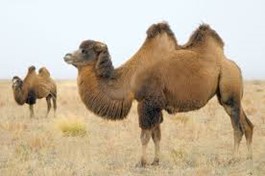
Take the Camel, as an example. The camel is called the ship of the desert. But every camel has the same, unique, complex features that must be fully present in order for it to survive. From its water-tank hump, or humps, its specially padded feet and knees, its extraordinary blood system to even its eyelids, the camel is unique to itself and its specific environment. These features are a must have for even the very first placental Camel birth to occur.
Going a bit further, there are actually two sets of functions that every bird, fish or mammal must have in order to be that first camel, armadillo, whale, or mammal. They first must be born. That in itself is hugely complicated. Second, they must be born with all bodily systems in full function.
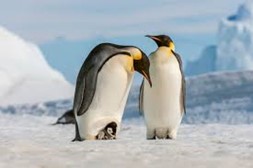
For the Penguin, that means a blood flow system that keeps the feet from freezing and maintaining proper pressures at ocean depths and it needs to have a complex vision in order to see its prey in various sight conditions.
In penguins, the blood has a much higher concentration of haemoglobin than is necessary solely for circulatory needs, and this is used as an oxygen store during underwater dives. In addition the muscle tissues have high concentrations of myoglobin, which also stores oxygen in the very place that it is most needed for underwater swimming.
Penguins dive in search of prey, and then having located it they chase it, and swallow it whole under water. To locate and capture prey therefore requires good underwater vision, but the differing refractive indexes of water and air require different shaped lenses. Penguins therefore are able to alter the shape of the lens considerably, enabling them to compensate for the differences in refractive index, and allowing good vision in air and water. Go to www.saintsalive.com and read Consider the Penguin by Ed Decker.
While we are talking about penguins, even though they do not fly, they are birds and like all within this specie, they lay and hatch eggs.
They are part of the world of birds with a worldwide population that is 5 times greater than the worldwide population of humans.
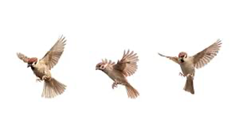
“The consensus among ornithologists is that our planet is currently home to between 9,500 and 11,000 species of birds, making them one of the most abundant types of creatures in the world.
Concerning the size of all bird populations, the most recent estimate — which involved big data analytics and artificial intelligence — pegs the number of individual birds at around 50 billion. About six birds are chirping and flapping their wings for every human. This estimate doesn’t include farmed animals, such as chickens, which numbered nearly 35 billion in 2023.” https://www.zmescience.com/feature-post/natural-sciences/animals/birds/how-many-birds-are-there-in-the-world/
I know I am being redundant, but that would require up to 11,000 males and 11,000 female birds to independently have all birthing systems fully operating before the birth of any singular “first Bird” in each of all 11,000 species.
Since the only way every single one of the 50,000,000,000 birds can be born is through the hatching of an egg, we get back to the conundrum of which came first, the chicken or the egg. In even the simplest of answers, there is no way on earth for an egg to come first. A fully functioning pair of birds would have to be there to fertilize the egg and sit on it and hatch it to get a baby bird. There is no ‘somehow’ involved.
In order for any species, bird, fish, or mammal to be present, it has to have first been born through its own species’ birthing function. In order to be born, it has to have ‘parents’ and there-in is the Fatal flaw of evolution.
Because I am a product of one group of these twelve general orders of placental mammals, I will share some facts about the impossibility of a placental first birth through an evolutionary process. Every single function of placental reproduction would have to be in place for both of the ‘first ‘parents’ to conceive that first born offspring. If even one of the hundred plus functions of just the umbilical cord was missing, there would not be an offspring. Let’s look at our own parentage, as the ultimate end of supposed evolution.
I read an article a while back that described the miracles of the umbilical cord. Again, the very first placental human child could never be born without its mother having all of the hundred plus functions up and working from day one. It couldn’t happen.
Twelve general orders of placental mammals and some
- Examples
- Insectivora: Shrews, hedgehogs, voles
- Chiroptera: Bats
- Primate: Monkey, ape, human
- Xehathra: Anteaters, sloths, armadillos
- Rodentia: Rats, mice, beavers
- Lagomorpha: Rabbits, hares
- Carnivora: Lions, bears, otters, weasels
- Proboscidea: Elephants
- Sirenia: Manatees, dugongs
- Perissodactyla: Horse, zebra, rhino
- Artlodactyla: Deer, antelope, cattle, pig, hippo
- Cetacea: Whales, dolphins
https://quizlet.com/140835713/12-orders-of-placental-mammals-flash-cards/
Let’s take a deeper look at the Umbilical Cord.
“The umbilical cord in placental mammals connects a baby in the womb to its mother. It runs from an opening in the baby’s stomach (the umbilicus) to the placenta in the womb. The average cord is about 50cm (20 inches) long. In the placenta, oxygen and food from the mother’s bloodstream pass into her baby’s bloodstream and are carried to the baby along the umbilical cord.
Blood circulates through vessels in the cord, which consists of:
- one vein that carries blood rich in oxygen and nutrients from the mother to the baby.
- two arteries that return deoxygenated blood and waste products, such as carbon dioxide, from the baby back to the placenta.
- These blood vessels are enclosed and protected by a sticky substance called Wharton’s jelly, which itself is covered by a layer of membrane called the amnion.
Towards the end of a pregnancy, the placenta passes antibodies through the umbilical cord from mother to baby, giving it immunity from infections for about three months after birth.
Then, what are the functions of umbilical cord? Mainly, it has three different functions. The first function is that it is able to serve the fetus a blood source. It is very important since the fetus is not able to breathe. It does not have either functioning lungs or an oxygen source. Also, it serves the fetus oxygen through the blood to serve the life of the fetus.
The second main function of the umbilical cord is that it is to serve the fetus a nutrients source such as proteins, calories, and fats as well. In addition, it is also able to serve the nutrients and also vitamins.
The last function of this cord is that it is able to transfer the de-oxygenated and waste products away out of the fetus. It transfers those substances to the maternal circulation in which they can be processed and then excreted.
Then, what are the features that the umbilical cord has? Basically, it is made of a substance which is known as Wharton’s Jelly, connective tissue or skin. It carries some features such as one vein which has two arteries and oxygenated blood. The vein of the umbilical goes to the liver of the fetus.
Here, it splits into two parts. One part of this vein is to supply the blood to the hepatic polar vein. It works to supply the blood to the liver. The other one is called as the ductus venosus. It is supply the blood to the whole human body of up 80%. It allows the vital nutrients such as oxygen to flow all over the fetus.”
Another amazing thing about the umbilical cord is that when the newborn takes that first breath, the whole thing reverses turns the whole job over to the baby.
@The Marvelous Umbilical Cord, by Ed Decker, www.saintsalive.com
The first and all following placental embryos, no matter how well into evolution they could ever be, could never have survived to full term and birth, without ALL the above things working perfectly.
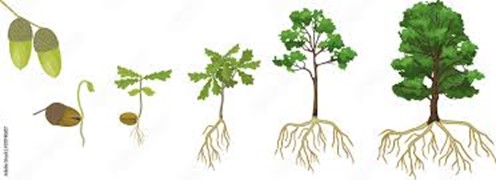
I have given you a look at just the ‘tip of the iceberg’. If we go a little deeper, we can talk about the perfect reproductive systems of 73,000 different tree species or the 382,000 species of plants, some 80% producing flowers that draw bees and other insects that take pollen from the male anther of a flower to the female stigma.
The goal of every living organism, including trees and plants, is to create offspring for the next generation. One of the ways that plants produce offspring is by making seeds. Seeds contain the genetic information to produce a new plant. The life cycle and structure of every plant or tree is very specific and in each life cycle. For example, excess carbon dioxide (CO2) builds up in the earth gases and are clearly not eco-friendly. Yet, Trees absorb the C0o2, removing the carbon and releasing oxygen into the air. In One year, a single acre of trees absorbs the same amount of CO2 produced by driving your gas fueled car 26,000 miles. https://www.treepeople.org/22-benefits-of-trees/
“Evaporation, Condensation, and Precipitation

We can also study the complex water system. It is the core of life itself. The water cycle describes how water is exchanged (cycled) through Earth’s land, ocean, and atmosphere. Water always exists in all three phases, and in many forms—as lakes and rivers, glaciers and ice sheets, oceans and seas, underground aquifers, and vapor in the air and clouds. This is hardly something that just evolved. It had to be in place before life could exist.
The water cycle consists of three major processes: evaporation, condensation, and precipitation.
“Evaporation
Evaporation is the process of a liquid’s surface changing to a gas. In the water cycle, liquid water (in the ocean, lakes, or rivers) evaporates and becomes water vapor.
Water vapor surrounds us, as an important part of the air we breathe. Water vapor is also an important greenhouse gas. Greenhouse gases such as water vapor and carbon dioxide insulate Earth and keep the planet warm enough to maintain life as we know it. Increasing amounts of greenhouse gases in the atmosphere also contribute to global warming.
The water cycle’s evaporation process is driven by the sun. As the sun interacts with liquid water on the surface of the ocean, the water becomes an invisible gas (water vapor). Evaporation is also influenced by wind, temperature, and the density of the body of water.
“Condensation
Condensation is the process of a gas changing to a liquid. In the water cycle, water vapor in the atmosphere condenses and becomes liquid.
Condensation can happen high in the atmosphere or at ground level. Clouds form as water vapor condenses, or becomes more concentrated (dense). Water vapor condenses around tiny particles called cloud condensation nuclei (CCN). CCN can be specks of dust, salt, or pollutants. Clouds at ground level are called fog or mist.
Like evaporation, condensation is also influenced by the sun. As water vapor cools, it reaches its saturation limit, or dew point. Air pressure is also an important influence on the dew point of an area.
“Precipitation
As is the case with evaporation and condensation, precipitation is a process. Precipitation describes any liquid or solid water that falls to Earth as a result of condensation in the atmosphere. Precipitation includes rain, snow, and hail.
Fog is not precipitation. The water in fog does not condense sufficiently to precipitate, or liquefy and fall to Earth. Fog and mist are a part of the water cycle called suspensions: They are liquid water suspended in the atmosphere.
Precipitation is one of many ways water is cycled from the atmosphere to the earth or ocean.
“Other Processes
Evaporation, condensation, and precipitation are important parts of the water cycle. However, they are not the only ones.
Runoff, for instance, describes a variety of ways liquid water moves across land. Snowmelt, for example, is an important type of runoff produced as snow or glaciers melt and form streams or pools.
Transpiration is another important part of the water cycle. Transpiration is the process of water vapor being released from plants and soil.
Plants release water vapor through microscopic pores called stomata. The opening of stomata is strongly influenced by light, and so is often associated with the sun and the process of evaporation. Evapotranspiration is the combined components of evaporation and transpiration, and is sometimes used to evaluate the movement of water in the atmosphere.”
https: //education.nationalgeographic.org/resource/hydrologic-cycle/
As I sit here at my computer this sunny day, a butterfly is floating at the window at my desk, sort of saying, “What about me? I’m as unique as any elephant.” That set me to looking at the complex life cycle of butterflies and sundry moths.These random sidetracks could turn this into a book. But, let’s see what the experts say about the subject.
Butterfly Life Cycle
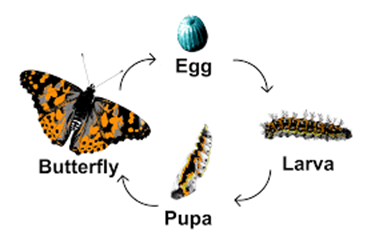
The butterfly and moth develop through a process called metamorphosis. This is a Greek word that means transformation or change in shape.
Insects have two common types of metamorphosis. Grasshoppers, crickets, dragonflies, and cockroaches have incomplete metamorphosis. The young (called a nymph) usually look like small adults but without the wings.
Butterflies, moths, beetles, flies and bees have complete metamorphosis. The young (called a larva instead of a nymph) is very different from the adults. It also usually eats different types of food.
There are four stages in the metamorphosis of butterflies and moths: egg, larva, pupa, and adult.
- Egg
Eggs are laid on plants by the adult female butterfly. These plants will then become the food for the hatching caterpillars.
Eggs can be laid from spring, summer or fall. This depends on the species of butterfly. Females lay a lot of eggs at once so that at least some of them survive. Butterfly eggs can be very small.
- Caterpillar: The Feeding Stage
The next stage is the larva. This is also called a caterpillar if the insect is a butterfly or a moth.
The job of the caterpillar is to eat and eat and eat. As the caterpillar grows it splits its skin and sheds it about 4 or 5 times. Food eaten at this time is stored and used later as an adult.
Caterpillars can grow 100 times their size during this stage. For example, a monarch butterfly egg is the size of a pinhead and the caterpillar that hatches from this tiny egg isn’t much bigger. But it will grow up to 2 inches long in several weeks.
- Pupa: The Transition Stage
When the caterpillar is full grown and stops eating, it becomes a pupa. The pupa of butterflies is also called a chrysalis.
Depending on the species, the pupa may suspended under a branch, hidden in leaves or buried underground. The pupa of many moths is protected inside a coccoon of silk.
This stage can last from a few weeks, a month or even longer. Some species have a pupal stage that lasts for two years.
It may look like nothing is going on but big changes are happening inside. Special cells that were present in the larva are now growing rapidly. They will become the legs, wings, eyes and other parts of the adult butterfly. Many of the original larva cells will provide energy for these growing adult cells.
- Adult: The Reproductive Stage
The adult stage is what most people think of when they think of butterflies. They look very different from the larva. The caterpillar has a few tiny eyes, stubby legs and very short antennae. The adults have long legs, long antennae, and compound eyes. They can also fly by using their large and colorful wings. The one thing they can’t do is grow.
The caterpillar’s job was to eat. The adult’s job is to mate and lay eggs. Some species of adult butterflies get energy by feeding on nectar from flowers but many species don’t feed at all.
Flying comes in handy. The adult female can easily fly from place to place to find the right plant for its eggs. This is important because caterpillars can’t travel far.
Most adult butterflies live only one or two weeks, but some species hibernate during the winter and may live several months.
https://ansp.org/exhibits/online-exhibits/butterflies/lifecycle/
Finally, it’s time to bring a bit of reality to this idea of hundreds of thousands of unique species rising out of the muck of some pond somewhere being the creative force of the all the life in this world we live in. It never happened
When I was a child, we used to say, “Which came first, the chicken or the egg.” I would always say that the chicken had to come forth first in order to lay the egg. But the only way a chicken could come forth was by hatching from an egg.
Let me ask you, which came first, the salmon or the egg? I want to go into a bit of detail here, because the life cycle of the salmon is clear evidence of that fatal flaw of evolution. There are over 9,000 salmon population groups just in British Columbia alone.

First, no salmon ever came forth without the egg first. And this requires first, a full-grown female and a full-grown male, both of them having arrived at the same spawning bed at the end of their life cycle. The salmon spawning beds are a place of return for the specie. They are a place of returning home to where they were spawned.
This homing is accomplished by tracing “pheromones” or chemical tracers that they use to reach their birth places. I would estimate that there are thousands of rivers, streams, creeks [I live next to one] and other waterways that millions of salmon use without taking a wrong turn somewhere in-route. Tell me again that this is all by a ‘somehow’ chance.
Once at the spawning spot, the female lays the eggs and the male passes over them, depositing the sperm. The female then buries them until the eggs hatch. And soon another cycle of life begins.
Let’s wrap this up.
Clearly, with abounding evidence, there can be no second generation without a fully functional first generation. In every species on the earth, the first parent, [Mammal. Fish. Bird. Plant or Tree. Every reptile, Bug, or Bee], must be a fully functioning parent, wholly able to procreate and form the second generations of their kind.
There is no other way that this could be except that “somehow” they were placed there intact on day one of the process. But it isn’t a somehow. It’s a “Someone.”
The Genesis, Chapter 1 version of creation says that this Someone is God, our creator.
27 So God created man in His own image; in the image of God He created him; male and female He created them. 28 Then God blessed them, and God said to them, “Be fruitful and multiply; fill the earth and subdue it; have dominion over the fish of the sea, over the birds of the air, and over every living thing that [h]moves on the earth.”
29 And God said, “See, I have given you every herb that yields seed which is on the face of all the earth, and every tree whose fruit yields seed; to you it shall be for food. 30 Also, to every beast of the earth, to every bird of the air, and to everything that creeps on the earth, in which there is [i]life, I have given every green herb for food”; and it was so. 31 Then God saw everything that He had made, and indeed it was very good. So the evening and the morning were the sixth day. [Genesis 1: 27-31]
We live in the miracle of life. Given to us by our God of miracles. There are no maybes, no some-hows, no accidents.
The odds are vastly more than a trillion to the tenth power for the first bog-glob to mindlessly evolve into a human.
Send me your thoughts!
Ed Decker
